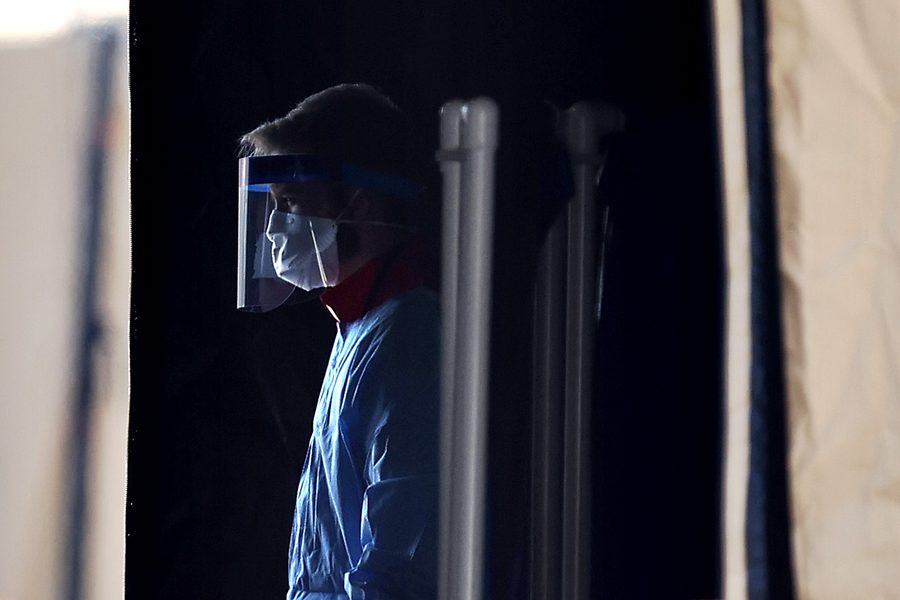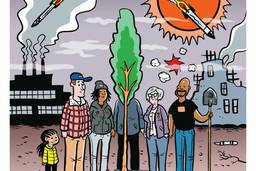A Federal Jobs Program for Contact Tracing
To safely reopen the economy, we need a public health corps. Here’s how to build it.
Dayton Martindale

As of last Thursday, 26.5 million Americans had filed for unemployment in a five-week span, as businesses not deemed essential are scaling back or shuttering entirely. Yet perhaps the most essential work of all remains stubbornly undone.
To safely reopen the economy without new waves of infection and death, virtually everyone who has written on the topic has been repeating the same urgent recommendation for months: The United States must ramp up testing, and with it employ a robust program of “contact tracing.” That is, we must reach out to those who test positive, determine who they have been in close contact with, alert these contacts that they may have been exposed, and ensure that these contacts are able to effectively quarantine. While technological tools play a role in this, providing personalized support will take people power.
In response, several cities and states have begun bringing on paid staff and volunteers for tracing, but these local actions are far from the scale needed. Experts suggest the United States will need a bare minimum of 100,000 to perform this task, while former Centers for Disease Control and Prevention (CDC) director Tom Frieden has suggested as many as 300,000. And this is only one of many pandemic-related tasks for which our badly understaffed public health system needs new recruits and fast.
In short, we face two interrelated problems: More people than ever are newly out of a job, and the government needs to rapidly expand its own workforce. The solution may seem obvious, and indeed a wide range of actors have called for federal hiring programs.
Unfortunately, Congress has thus far seemed more concerned with bailing out big business than with public health or unemployment. But recent proposals from a working group of Senate Democrats — and even, on Monday, from Joe Biden — suggest that there may be increased momentum behind something like a New Deal-era federal jobs program: a large civilian corps of public health workers hired primarily from the ranks of the unemployed. There’s no reason to wait: The next coronavirus bill should include funding for hundreds of thousands of public health jobs, including an explicit provision for 300,000 full-time, salaried contact tracers, managed by the CDC, to be recruited, trained and hired as soon as possible.
Where we’re at
Thus far, cities and states have taken the lead in contact tracing. Massachusetts has allied with the nonprofit Partners in Health to commit to employing 1,000 tracers (and received more than 15,000 applications). Washington state, which currently has 700 tracers, intends to reach 1,500 by the second week of May. In California, Gov. Gavin Newsom announced his intent to train a statewide tracing workforce of 10,000.
These efforts represent important steps forward, but they are not enough. For one, they’re too small: Univeristy of California San Francisco infectious disease expert George Rutherford estimated California might need three to four times that number.
Just as importantly, their patchwork nature is inadequate to addressing a crisis that doesn’t neatly respect state and county borders. According to Leif Wellington Haase, health policy consultant and former director of The Century Foundation’s Public Health Preparedness and Bioterrorism Project, while wealthier economies like California’s might be able to set up large-scale contact tracing, “There are lots of places in the country, especially in rural areas, where no one will set up contact tracing and there’ll be no impetus to set it up until it’s much too late.” A nationwide program could coordinate priorities, establish standardized protocol and reach otherwise neglected communities.
There’s one more big reason you need a national program: funding. States are unable to print their own money as the federal government can, and almost all are required to balance their budgets. Even if they do set aside funds for hiring contact tracers, this may come at the expense of cuts elsewhere — indeed, cuts have already begun. Some states are relying partly on volunteers, presumably to save money, but this is a missed opportunity when so many desperately need paid work. Plus, Haase adds, “unless you pay people you’re not going to have the first-rate, consistent, well-trained workforce that you ultimately need.”
The most recent federal coronavirus bill, signed into law April 24, does allocate $25 billion toward developing and implementing testing and related expenses, including contact tracing. While this is a respectable chunk of money, testing is expensive and will likely require the lion’s share of the funds.
One estimate from the Rockefeller Foundation suggested a scaled-up testing effort could cost $100 billion in the short term, and up to $500 billion over the next year. (Administering these tests could be another job for new public health workers.) While this estimate is on the high end, it’s clear that the nation’s public health infrastructure — whose per capita funding decreased 9% from 2008 to 2016, and which has been gutted further under Trump — is going to need more resources. Adequate testing enables tracing to be more comprehensive, but we can’t just neglect the latter: A federal jobs program for contact tracing will require its own dedicated funds.
What we need
The good news is that contact tracing is relatively cheap. Experts estimate that a full fleet of 300,000 would cost in the range of $10 to $15 billion, primarily in labor costs, depending on pay and benefits for workers. Pay proposals from various academics and think tanks range from $17 an hour to $50,000 plus benefits — let’s push for the latter, because even $15 billion is a tiny fraction of the trillions already spent an economic relief.
On April 22, one day after the Senate passed the latest relief bill, a working group of Senate Democrats released two proposals to ramp up hiring for federal public health. A third is reportedly on the way.
The first suggests a dramatic expansion of AmeriCorps and other national service programs — doubling to 150,000 workers in the next year, and 300,000 in each of the two years after — meant to perform not only public health tasks but education support and other needed services. (Expanding existing service corps is also the idea behind Biden’s newly proposed “U.S. Public Health Jobs Corps” for contact tracing, though the presumptive nominee did not flesh out many details.) Indeed, several AmeriCorps organizations are already doing pandemic-related work, such as mask-making and meal distribution; the bill would make this the norm across the entire network and ramp up capacity. The proposed legislation also sets up a new partnership between the CDC and AmeriCorps, creating a CDC Corps that could theoretically carry out contact tracing.
“Scaling up existing systems … can be helpful when you need to move fast,” says Daniel Edelman, associate director of strategy and operations at the policy think tank Next100 and co-author of that group’s recent report, “The Road to COVID-19 Recovery Is Long — But AmeriCorps Can Help.” Edelman underscores, “AmeriCorps has historically had bipartisan support, so it might be a good vehicle.”
One area where the plan might improve is pay: The bill does permanently increase AmeriCorps compensation to 175% of the federal poverty line — a significant boost over its current low rate, but, at $22,330 for a one-person household, far from a fair wage. An earlier bill from Sens. Ed Markey (D-Mass.) and Chris Van Hollen (D-Md.) — who also support the new proposal — had suggested 200% of the poverty line, and progressives should demand even more, including the right of participants to unionize.
In the second Senate proposal, introduced by Sens. Kirsten Gillibrand (D-N.Y.) and Michael Bennet (D-Colo.), the federal government would hire hundreds of thousands of workers for a new “Health Force.” This force would be managed by state and local agencies who best know what their communities need, but directed and coordinated by the CDC.
This health force would engage in everything from tracing contacts to administering tests to delivering food to the old, sick and immunocompromised.
This second proposal may be the most promising path toward a well-paid, full-scale contact tracing corps, as it is not constrained by AmeriCorps’ pay issues and leaves room for a greater number of workers (though the first can still play a complementary role).
The Senate Democrats in this working group have explicitly evoked the 1930s Works Progress Administration (WPA) and Civilian Conservation Corps (CCC) as models. These New Deal precedents show that government jobs programs can be popular not only among those who are employed, but among the community writ large, which benefits from the work itself as well as the broader economic boost.
This history also shows that jobs programs can get off the ground quickly. President Roosevelt pitched the CCC to Congress on March 21, 1933, and by late April, “they raised the first flag in the first CCC camp in the nation,” says Neil M. Maher, history professor at the New Jersey Institute of Technology and author of Nature’s New Deal: The Civilian Conservation Corps and the Roots of the American Environmental Movement. Part of what streamlined this process is that the CCC drew on existing government agencies to coordinate, rather than launching something new out of whole cloth.
A public health corps could do likewise. “The CDC absolutely has the internal knowledge and capacity to run something like this,” Haase says. Such a corps, he estimates, could be put together in about two months, assuming a competent and well-intentioned government. While that’s a big “if” in the current administration, contact tracing is a relatively easy job to train for — it primarily requires people skills and access to a phone, rather than any public health background or even a college degree. Laid-off workers from a wide range of backgrounds could participate. In Massachusetts, tracers who trained on a Thursday were making their first calls by the weekend.
The path forward
Perhaps the biggest obstacle to a federal public health corps is Mitch McConnell. So far, coronavirus relief bills, originating in the senate, have fallen short of protecting everyday working people; the most recent bill garnered the opposition of Rep. Alexandria Ocasio-Cortez (D-N.Y.) as well as several progressive groups including People’s Action, Sunrise and Indivisible. And the House, says Indivisible national policy director Angel Padilla, “is swallowing whatever the Senate gives it.”
For this reason, Padilla hopes the next bill — which could come this week, he says — will be drafted first in the House rather than the Senate, giving Democrats more control over what’s in it.
If this is the case, House Democrats might use one or both of the Senate Democrat proposals as a launching point, making a public health corps a key component of any relief program. They could flesh out the details to ensure a genuinely progressive result, with high pay and benefits, priority given to the jobless and marginalized, and, crucially, guarantees of privacy and data security.
Senator Markey has sent multiple letters to the Trump administration raising concerns about the potential for contact tracing technologies to violate civil liberties. Partnering with private entities will be necessary, he concedes — and has already begun, with several tech companies and even Michael Bloomberg all developing programs — but individuals’ information sharing must be voluntary. In addition, public and private actors must be fully transparent about what data they are collecting, why, and what it can be used for, with strict legal protections prohibiting access to any personal health information.
For all this to happen, Congress will likely need a push. So far, relatively little federal-level activism has prioritized testing and tracing. Understandably, community organizations and progressive politicians are focused on putting out the economic fires first — providing unemployment insurance and rent relief, for instance — which can feel more urgent and fits better within groups’ existing priorities and expertise. “Public health in and of itself is not really the main concern of federal politicians,” Haase says.
But in the long game, testing and tracing are essential to maintaining lives and livelihoods, and progressives should start pressuring their congresspeople to support a Health Force now. While conventional protests are now unsafe, organizers continue to send calls, emails, videos and tweets at legislators — there is anecdotal evidence politicians are replying to tweets more often, Padilla says — and other organizations are experimenting with creative new tactics. Members of unions and community organizations that are already organizing around COVID-19 relief can petition within their groups to add a public health corps to their list of demands.
McConnell is unlikely to be on board: He initially signaled that he thinks states should be able to take care of themselves (though he walked this back on Monday), and is in no rush to pass the next bill. Moving forward, then, it may be even tougher to wring concessions out of the Senate GOP.
But this “let-states-fend-for-themselves” strategy, which is already falling short, may contain the seeds of its own downfall. The decentralized approach reminds Maher of President Hoover’s posture toward the Great Depression — let local, state and private actors deal with it. This failed dramatically, priming Americans to support Roosevelt’s more active approach. Perhaps, as people watch the virus devastate their communities, McConnell’s failure will spur a similar shift.
There is evidence a public health corps could be popular. A similar proposal for a “Climate Conservation Corps” oriented around green jobs has 61% support and only 21% opposition, and polls show most Americans take the virus seriously. “I don’t think that people realize how angry the base is,” Padilla says.
Some of the experts In These Times spoke to suggest that, strategically, a public health corps is more likely to get through Congress framed as a temporary crisis response. But all of them underlined that the need for more public health workers does not end in a crisis. “The problem is when we think about these policies as crisis policies, that guarantees that they will be closed down as soon as people perceive that the crisis is gone,” says Pavlina Tcherneva, associate professor of economics at Bard College and the author of forthcoming book The Case for a Job Guarantee. “The pandemic will go away but the existential problems” — in the economy writ large and in our underfunded public health infrastructure — “will not go away.”
In fact, a permanent public health corps — or better yet, Tcherneva suggests, a full job guarantee — would make us far more prepared for the next crisis, be it another pandemic or some climate catastrophe. Had we had such a corps two months ago, we could have expanded contact tracing much more quickly smoothly. Many jobs that might now be considered pandemic response — child care for health workers, support for the elderly, food distribution — are needs that exist even in normal times, and a public health force might also be redirected to green jobs, as climate change, habitat destruction and pollution contribute to everything from infectious disease to cancer. A full jobs guarantee, Tcherneva says, would enable anyone to get a paycheck for making a valuable contribution to society, whether that’s putting up solar panels or, this spring, just staying home.
A federal jobs guarantee might seem unlikely to pass a McConnell Senate, but much that once felt unlikely is suddenly on the table. The support for mass hiring for public health by moderates like Biden, Michael Bennet and Amy Klobuchar suggest that some surprising faces may be open to New Deal-style programs — even if the Left will have to turn up the heat to make sure these programs are sufficiently robust.
We now have the opportunity to provide people well paying, meaningful work that genuinely helps the larger community, as we did in the 1930s. Or we can keep watching the virus eat away at our social and individual immune systems, causing the economy — and human bodies — to break down. The choice is straightforward: indefinite shutdown, mass death, or a federal public health corps.
Dayton Martindale is a freelance writer and former associate editor at In These Times. His work has also appeared in Boston Review, Earth Island Journal, Harbinger and The Next System Project. Follow him on Twitter: @DaytonRMartind.








